

Deformed stellar structures with rotation Tohoku 14th. Nov. (2016) 12 min. talk+3 min Chiba Institute of Technology Nobutoshi Yasutake MNRAS Letter (2015) 446, 56, MNRAS(2016) 463, 3705 NY, K.Fujisawa, S.Yamada + H.Okawa 16 年 11 月 21 日月曜日
“MOTIVATION” 16 年 11 月 21 日月曜日
Machida, Matsumoto, Inutsuka, (2008) ApJ K.Kotake, K.Sumiyoshi, S.Yamada, T.Takiwaki, T.Kuroda, Y.Suwa, H.Nagakura (2012) PTEP A big problem in astrophysics There is no scheme of time evolution for `` deformed stars” in quasi-equilibrium !! Supernovae evolution (1D) dynamical simulation(3D) PNSs( R ~ 50km) Heyney method (1964) in GR NSs( R ~ 10km) T ~ 30MeV T ~ 0 MeV ? Yl ~ 0.3 Y ν ~ 0 evolution (1D) Star formations Heyney method (1964) dynamical simulation(3D) Massive Stars, Proto-stars Planets, ... etc ? 16 年 11 月 21 日月曜日
Without assumption of rotational law, no one can get rotating structures. ? → No one knows rotation inside stars. Uniform rotation Differential rotation Rotating structures of neutron stars in fully GR formulation NY , Hashimoto, Eriguchi, PTP(2005) 16 年 11 月 21 日月曜日
⇩ P Pdot diagram Observations with the ansatz Dipole radiation = Loss rate of rotational energy Magnetic filed B = 3.2 x 10 19 (P ∂ tP) 1/2 G Characteristic age τ = P /(2 ∂ tP) s We are looking at rotation !! 16 年 11 月 21 日月曜日
“WEAK SOLUTION” MNRAS Letter (2015) 446, 56, MNRAS(2016) 463, 3705 NY, K.Fujisawa, S.Yamada =0 16 年 11 月 21 日月曜日
Mass coordinate each node: x, y, m, j, s, Ye, Yn, Yp, Y He ..... → dv, ρ , P , T, u, ... Variational Principle IMPORTANT POINTS ① Free boundary condition. ② Realistic EOS (baroclinic). ③ 100% conservative scheme. ④ However, numerical error is large close to the boundary with low mass element. 16 年 11 月 21 日月曜日
sellular-type APPLICATIONAL RESULTS 3 120 3 0.0004 YFY scheme � YFY scheme � 0.00038 100 0.00036 Z [10 5 km] 2 80 Z [10 5 km] 2 0.00034 60 0.00032 1 0.0003 We can trace stellar evolutions with 1 40 0.00028 20 ``entropy ( ⬇ )”, ``angular momentum ( ➡ )”. 0.00026 0 0 0 0 1 2 3 0 1 2 3 X [10 5 km] X [10 5 km] → If arbitral distributions of mass, entropy, angular momenta, and fraction, we can obtain hydrostatic equilibria in a 3 120 3 0.0005 YFY scheme � YFY scheme � conservative way. 100 0.00045 Z [10 5 km] 2 80 Z [10 5 km] 2 0.0004 60 0.00035 1 40 1 0.0003 20 0 0 0 0.00025 0 1 2 3 0 1 2 3 X [10 5 km] X [10 5 km] 3 120 3 0.0005 YFY scheme YFY scheme � � 100 0.00045 Z [10 5 km] Z [10 5 km] 2 80 2 0.0004 60 0.00035 1 40 1 0.0003 20 0 0 0 0.00025 0 1 2 3 0 1 2 3 X [10 5 km] X [10 5 km] uniform-like 16 年 11 月 21 日月曜日
uniqueness of solution 16 年 11 月 21 日月曜日
“STRONG SOLUTION” MNRAS(2017) in prep. NY, K.Fujisawa, H.Okawa, S.Yamada 16 年 11 月 21 日月曜日
HOW TO SOLVE ? f f - -1 dxdy = | J | dXdY PROBLEMS ① Lagrangian perturbation fails because of the gauge freedom. (Freedman&Shutz 1978) ② Hour-glass problem iso potential surface → 16 年 11 月 21 日月曜日
A new method based on a fixed point theorem H.Okawa, K.Fujisawa, R.Hirai, Y.Yamamoto, NY, H.Nagakura (in prep.) Naive Newton-Raphon methods does not work for multi-dimensional hydrostatic equilibria in Lagrange coordinate [Ref. Friedman & Schutz 1978]. We, then, introduce a new method, named as ``W4 method”, which is based on the fixed point theorem. F = Here, F=F(x 1 ,x 2 ,...y 1 ,y 2 ,...). .. . x 1 +A 1 x 1 + B 1 F =0 In Lagrange scheme, the variables are .. . ``coordinates” of nodes, which have mass, entropy, and angular momenta. x 2 +A 2 x 2 + B 2 F =0 : 【 tangent vector space on S 1 】 【 tangent vector space on S 2 】 Find a fixed point ⇔ Find a fixed point ⇔ Find a solution for Find a solution for 1st order differential eq. 2nd order differential eq. (SOR, Newton method etc.) (W4, MD calculation etc.) → Sometime, → There must be there is no fixed point. fixed points. 16 年 11 月 21 日月曜日
“STRONG SOLUTION (ID TEST)” MNRAS (in prep) A extended initial-model and a shrinked initial-model provide the same result. Initial models Final result 200 200 x1.2 x1.2 180 180 x0.8 x0.8 160 160 140 140 120 � [g/cc] 120 � [g/cc] 100 100 80 80 60 60 40 40 20 20 0 0 0 0.5 1 1.5 2 2.5 3 3.5 0 0.5 1 1.5 2 2.5 3 3.5 r [10 5 km] r [10 5 km] Weak solution Strong solution viral constant convergence condition residual = | ∇ P/ ρ + Φ |/(| ∇ P/ ρ |+| Φ |) の max < 1.e-5 High resolution ``does” !! High resolution ``does not” N=30 → VC= 6.3e-2 improve numerical accuracy, N=60 → VC= 3.3e-2 since finite volume does not N=100 → VC= 2.0e-2 contribute to total energy. 16 年 11 月 21 日月曜日
SUMMARY We introduce two new methods to obtain baroclinic equilibria in multi-dimension, for weak solutions and strong solutions. Our weak-solution method can trace mass element for the entropy and the angular-momentum evolution, but the local balance eq. may be broken. weak solution → strong solution Our strong-solution method is successful for 1D test-calculation. Our scheme will be a break-through not only for studies on main-sequence stars but also on planets, compact stars, etc. Future work radiation, convection, mass loss, observation, GR, 3D, magnetic filed.... 16 年 11 月 21 日月曜日
Recommend
More recommend